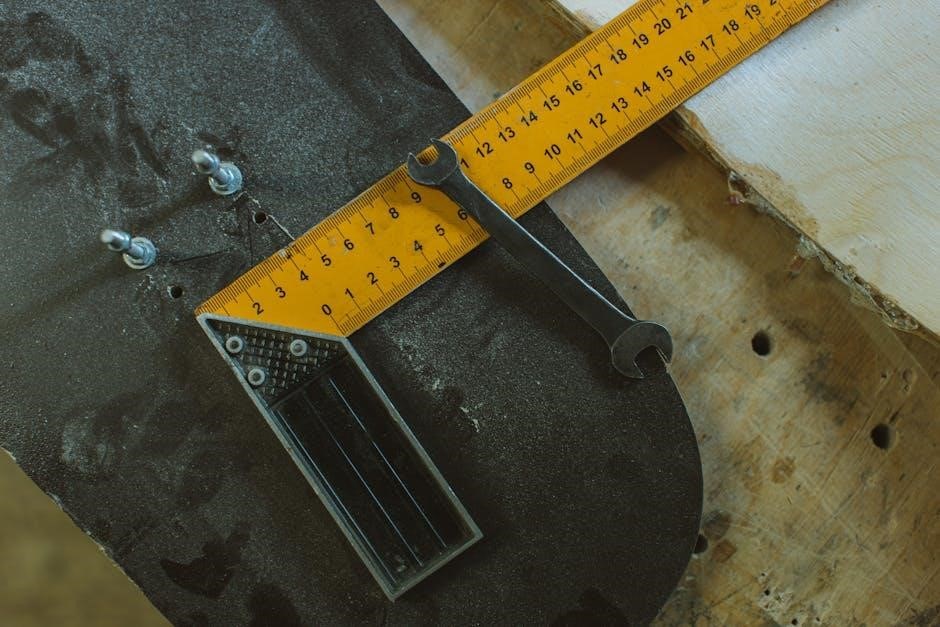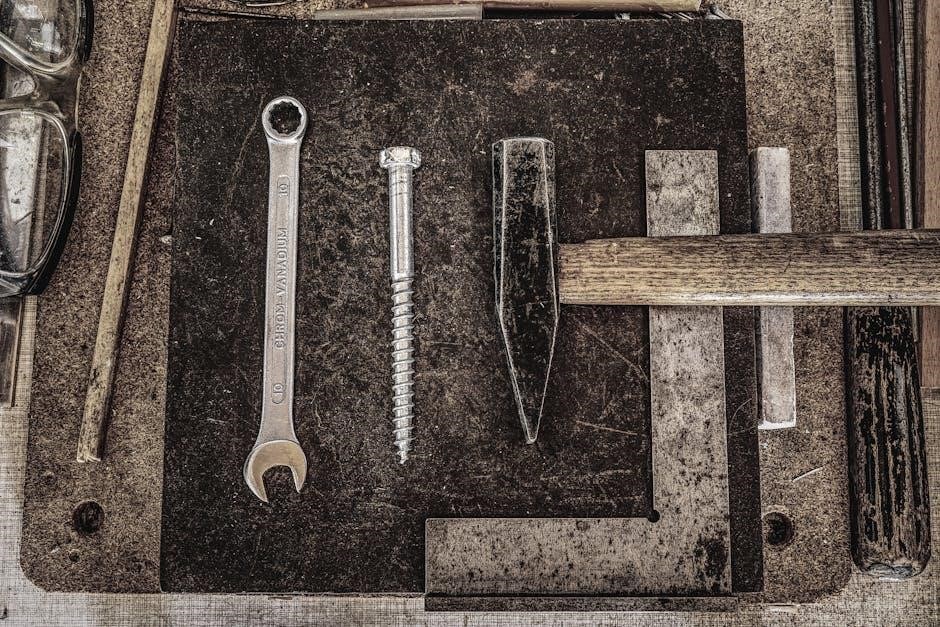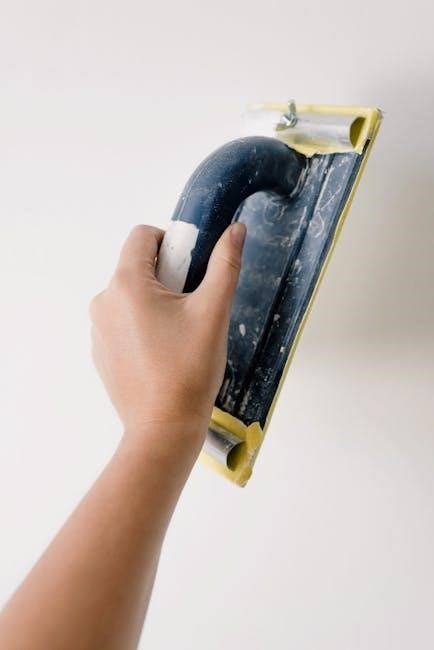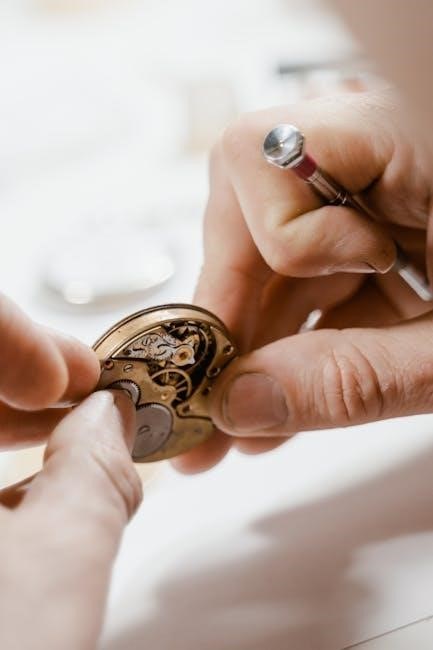Manual transmission repair involves diagnosing and fixing issues in the gearbox․ It requires mechanical skills and knowledge․ Regular maintenance prevents major breakdowns․
1․1 Overview of Manual Transmissions
Manual transmissions, also known as stick shifts, are gearboxes that require driver input to change gears․ They consist of a set of gears, a clutch, and shafts that transmit power from the engine to the wheels․ Unlike automatic transmissions, manual systems rely on the driver to engage and disengage the clutch pedal while shifting gears․ This design provides better fuel efficiency, lower production costs, and greater control over vehicle performance․ Manual transmissions are commonly used in vehicles that require precise acceleration and speed management․ Understanding their operation is essential for effective repair and maintenance․ Regular upkeep ensures smooth shifting and optimal performance․
1․2 Importance of Regular Maintenance
Regular maintenance is crucial for extending the life of a manual transmission․ Lubricating gears and components prevents excessive wear, while checking transmission fluid ensures proper gear engagement․ Inspecting gaskets and seals helps prevent leaks, which can lead to costly repairs if left unaddressed․ Additionally, regular clutch inspections can identify wear early, avoiding sudden failure․ Addressing these issues promptly ensures smooth operation and prevents minor problems from escalating․ Neglecting maintenance can result in premature wear, noisy operation, and eventual breakdowns․ Staying proactive with maintenance not only saves money but also enhances driving performance and reliability․ Consistent care is essential for optimal transmission function․

Common Problems in Manual Transmissions
Manual transmissions often face issues like slipping gears, clutch wear, and noisy operation․ Leaks, fluid loss, and misalignment can also arise, requiring prompt attention to avoid further damage․
2․1 Slipping Gears
Slipping gears occur when the transmission fails to stay engaged, causing loss of power․ This can happen due to worn synchronizers or clutch packs․ It often manifests as unexpected shifting during acceleration or deceleration․ Drivers may notice a delay or hesitation when changing gears․ If left unaddressed, slipping gears can lead to further damage, such as gear wear or transmission failure․ Regular inspection and lubrication of components can help prevent this issue․ Additionally, ensuring proper alignment during repairs is crucial to avoid recurrence․ Addressing slipping gears promptly is essential for maintaining smooth and efficient transmission performance․
2․2 Clutch Wear and Failure
Clutch wear and failure are common issues in manual transmissions․ Overuse, riding the clutch, or improper engagement can cause the clutch to degrade․ Symptoms include slipping, difficulty shifting gears, and a spongy pedal feel․ If the clutch fails completely, the vehicle may not move at all․ Replacing the clutch involves removing the transmission and inspecting the flywheel for damage․ Proper alignment and lubrication are essential during reinstallation to ensure smooth operation․ Regular maintenance, such as checking the clutch cable and fluid levels, can help prevent premature wear․ Addressing clutch issues early prevents costly repairs and ensures reliable performance․
2․3 Noisy Operation
Noisy operation in manual transmissions is often caused by worn bearings, loose mounts, or damaged gears; Grinding, whining, or clunking sounds during shifting indicate potential issues․ Bearings wear over time, leading to uneven gear rotation and noise․ Loose transmission mounts can cause vibrations, resulting in clunking sounds․ Damaged gears may produce grinding noises during shifts․ Ignoring these symptoms can lead to further damage, such as gear failure․ Regular lubrication and inspection of components can help prevent excessive wear․ Addressing noisy operation early ensures smoother performance and avoids costly repairs․ Always inspect and replace faulty parts to maintain optimal transmission function․
2․4 Leaks and Fluid Loss
Leaks and fluid loss in manual transmissions can lead to serious damage if left unaddressed․ Common sources of leaks include worn seals, gaskets, or damaged transmission pans․ Low fluid levels can cause gears to overheat and wear down prematurely․ Regular inspections of the transmission pan, seals, and connections are essential to identify leaks early․ Using the correct type of transmission fluid is crucial to maintain lubrication and prevent corrosion․ Addressing leaks promptly ensures optimal performance and prevents costly repairs․ Always check for signs of fluid loss, such as puddles under the vehicle or discolored fluid, to maintain transmission health․

Tools and Equipment Needed for Repair
Essential tools include wrenches, sockets, and gear pullers․ Specialized equipment like transmission jacks and bearing presses are also required for efficient manual transmission repair․
3․1 Essential Tools
Essential tools for manual transmission repair include a socket set, wrenches, and screwdrivers․ A torque wrench ensures proper bolt tightening․ Gear pullers are necessary for removing bearings․ Pliers and punches help with small parts․ A transmission jack safely lifts the unit․ Lubrication tools like grease guns keep components running smoothly․ Workshop manuals provide repair guidance․ Proper tools prevent damage and ensure efficient repairs, making them indispensable for any manual transmission work․
3․2 Specialized Equipment
Specialized equipment for manual transmission repair includes transmission presses for bearing installation․ Hydraulic test benches diagnose internal issues․ Precision measuring tools like micrometers inspect gear tolerances․ A parts cleaner degreasers components effectively․ A universal joint puller removes driveshaft connections․ Advanced diagnostic tools, such as gear lapping compound, ensure smooth gear operation․ These tools are crucial for complex repairs and ensuring system reliability, though they may require significant investment and technical expertise for proper use․

Step-by-Step Repair Process
A systematic approach to manual transmission repair ensures efficiency․ Begin with disassembly, followed by component inspection and replacement․ Reassemble carefully, then test functionality to confirm repairs․
4․1 Disassembling the Transmission
Disassembling a manual transmission requires care and precision․ Start by removing the gearshift and bearings․ Use specialized tools to detach the main shaft and countershaft․ Next, extract the gear clusters, ensuring all components remain organized․ Be cautious with seals and gaskets to avoid damage․ Document each step for reassembly․ Proper disassembly is crucial for effective inspection and repair․ Always refer to a repair manual for specific instructions tailored to your transmission model․ Patience and organization are key to a successful process․
4․2 Inspecting and Replacing Components
After disassembling, inspect each component for wear or damage․ Check gears for scoring, bearings for smooth rotation, and synchros for proper engagement․ Replace any worn-out parts, such as the clutch, seals, or gaskets․ Use a micrometer to measure gear teeth and bearings for accuracy․ Lubricate new components before installation to ensure smooth operation․ Always follow manufacturer specifications for replacements․ A thorough inspection ensures reliability and prevents future issues․ Keep track of all replaced parts to maintain a record for future reference․ This step is critical for restoring the transmission’s performance and longevity․
4․3 Reassembling the Transmission
Reassembling the transmission requires precision and care․ Start by cleaning all components thoroughly and applying a thin layer of lubricant to moving parts․ Reinstall gears, bearings, and synchros in the correct order, ensuring proper alignment․ Tighten bolts gradually and in the specified sequence to avoid warping․ Reattach the clutch and pressure plate, aligning the splines carefully․ Use a torque wrench to secure all components according to manufacturer specifications․ Double-check the alignment of gears and shafts before finalizing․ Once reassembled, test the transmission by shifting through gears to ensure smooth operation․ Proper reassembly is crucial for restoring functionality and durability․

4․4 Testing the Repaired Transmission
After reassembling the transmission, thoroughly test it to ensure proper function․ Start by checking for leaks and ensuring all fluid levels are correct․ Test the clutch engagement and gear shifts in a controlled environment, such as a driveway․ Shift through all gears, including reverse, to confirm smooth operation․ Listen for unusual noises or vibrations, which could indicate misalignment or worn components․ Perform a test drive under various conditions, including uphill and stop-and-go traffic, to assess performance․ If any issues arise, such as slipping or grinding, revisit the repair steps to identify and correct the problem․ Proper testing ensures reliability and safety․

Maintenance Tips to Prevent Future Issues
Regular fluid checks, monitoring clutch wear, and inspecting gear lubrication are essential․ Schedule periodic inspections and adhere to manufacturer recommendations to ensure optimal performance and longevity of the transmission․
5․1 Fluid Changes
Fluid changes are crucial for maintaining the health of a manual transmission․ Over time, the transmission fluid degrades, losing its lubricating properties and ability to cool components․ Old fluid can become contaminated with metal shavings and debris, leading to premature wear on gears and bearings․ It is recommended to replace the fluid every 30,000 to 60,000 miles, depending on the vehicle manufacturer’s specifications․ Always use the correct type of fluid specified for your transmission to ensure optimal performance and longevity․ Regular fluid changes help prevent corrosion, reduce friction, and maintain smooth gear operation, avoiding costly repairs down the road․
5․2 Clutch Maintenance
Clutch maintenance is essential for smooth operation and longevity․ Drivers should avoid riding the clutch, as this causes unnecessary wear on the clutch disc and pressure plate․ Regular inspection of the clutch pedal’s free play ensures proper engagement and prevents premature wear․ Lubricating the clutch linkage and pivot points can reduce friction and noise․ Replacing the clutch fluid periodically helps maintain hydraulic system efficiency․ Signs of wear, such as slipping or a spongy pedal, should be addressed promptly․ Proper maintenance can extend the clutch’s lifespan, preventing costly replacements and ensuring reliable performance in your manual transmission system․
5․3 Gear Lubrication
Proper gear lubrication is vital for reducing friction and wear in manual transmissions․ Using the correct type of gear oil or grease ensures smooth operation and extends component life․ Regular lubrication should be performed during repairs or as part of routine maintenance․ Apply lubricant to gear teeth, bearings, and synchros to minimize heat buildup and prevent corrosion․ Always check the manufacturer’s recommendations for the appropriate lubricant type․ Improper lubrication can lead to increased wear, noise, and premature failure․ Keep the transmission clean and well-lubricated to maintain optimal performance and reliability over time․

Troubleshooting Common Repair Mistakes
Identifying errors early prevents costly rework․ Common issues include improper alignment and insufficient lubrication․ Addressing these mistakes ensures a reliable repair and extends transmission lifespan․
6․1 Improper Alignment
Incorrect alignment of parts during reassembly is a common mistake․ Misaligned gears or bearings can cause poor shifting and increased wear․ Always use alignment tools and follow the manufacturer’s specifications to ensure everything fits properly․ Double-checking each component’s position before tightening is crucial․ Improper alignment can lead to premature failure of the transmission, requiring costly repairs․ Taking the time to align parts correctly saves time and money in the long run․ Proper alignment ensures smooth operation and prevents further damage․

6․2 Insufficient Lubrication
Insufficient lubrication is a common oversight during manual transmission repair․ Without proper grease or oil, moving parts like bearings and gears wear down rapidly, leading to noisy operation and premature failure․ Always apply the recommended lubricant to all components before reassembly․ Use the correct type and amount specified by the manufacturer to ensure optimal performance․ Regular lubrication checks can prevent this issue․ Neglecting this step can result in costly repairs, as damaged parts may need replacement․ Proper lubrication ensures smooth shifting, reduces friction, and extends the transmission’s lifespan․ It’s a simple yet critical step in maintaining transmission health․
6․3 Worn or Damaged Seals
Worn or damaged seals are a frequent issue in manual transmission repair․ Seals prevent fluid leaks and contamination, so their failure can lead to serious problems․ Signs include fluid leakage, contaminated gear oil, and slippage․ Inspect seals during disassembly and replace them immediately if damaged․ Use high-quality replacement seals to ensure durability․ Proper installation is crucial to avoid further damage․ Neglecting this step can result in costly repairs and reduced transmission performance․ Always check for wear and tear during maintenance to prevent sudden failures․ Replacing seals early helps maintain transmission efficiency and prevents more severe issues down the line․

When to Seek Professional Help
Seek professional help for complex manual transmission repairs, especially if you lack experience․ Experts handle intricate diagnostics and specialized tools, ensuring reliable and long-lasting solutions․
7․1 Complex Repairs
Complex manual transmission repairs often require specialized tools and expertise․ Issues like gear tooth damage or bearing failure demand precision and experience to avoid further damage․ DIY attempts can lead to costly mistakes, making professional intervention crucial for such cases․ Experts use advanced diagnostic equipment to identify and correct problems effectively, ensuring the transmission operates smoothly and reliably․ These repairs also involve intricate disassembly and reassembly processes, best handled by trained technicians․ Therefore, seeking professional help is highly recommended for complex transmission repairs to guarantee safety and performance․
7․2 Specialized Diagnostics
Specialized diagnostics are essential for accurately identifying complex issues in manual transmissions․ Advanced tools like scan tools and endoscopes help technicians detect internal damage or wear without disassembling the transmission․ These diagnostics can reveal problems such as worn bearings, cracked gear teeth, or faulty synchronizers․ Professional mechanics use these tools to analyze gear engagement patterns, fluid condition, and operational noises․ Detailed diagnostic reports guide precise repairs, ensuring that only necessary components are replaced․ This approach minimizes downtime and avoids unnecessary costs․ Specialized diagnostics are a cornerstone of modern transmission repair, enabling technicians to address issues efficiently and effectively․

7․3 Warranty and Insurance Considerations
Warranty and insurance considerations are crucial when dealing with manual transmission repairs․ If the vehicle is under warranty, certain repairs may be covered, reducing out-of-pocket costs․ It’s important to review the warranty terms to understand what is included․ Insurance coverage varies, but collision or comprehensive policies may cover transmission damage caused by accidents or unforeseen events․ Always consult with the manufacturer or insurer to confirm coverage before proceeding with repairs․ Additionally, using authorized repair shops ensures that warranty terms remain valid․ Understanding these considerations helps in making informed decisions and avoiding financial surprises during the repair process․
Manual transmission repair requires skill and attention to detail․ Regular maintenance and timely fixes ensure smooth operation and extend lifespan․ DIY enthusiasts should approach repairs with caution․
8․1 Summary of Key Points
Manual transmission repair involves understanding its components and addressing issues like wear, leaks, and clutch failure․ Regular maintenance, such as fluid changes and inspections, is crucial․ DIY enthusiasts should master tools and techniques but know when to seek professional help․ Troubleshooting common mistakes, like improper alignment or insufficient lubrication, ensures successful repairs․ Preventative measures, such as proper gear lubrication, extend transmission lifespan․ Complex issues may require specialized diagnostics or tools․ Staying informed and proactive helps maintain optimal performance and avoids costly breakdowns․ Consistent care and timely interventions are key to preserving manual transmissions․
8․2 Final Tips for DIY Enthusiasts
For DIY enthusiasts tackling manual transmission repair, patience and attention to detail are essential․ Always refer to a repair manual for specific guidance․ Use high-quality tools and ensure the workspace is clean to avoid contamination․ Start with simple tasks like fluid changes before progressing to complex repairs․ Keep spare parts on hand and label components during disassembly for easier reassembly․ Practice on older or less critical vehicles before working on your primary car․ Join forums or communities for support and advice․ Remember, safety first—use jack stands and proper lifting techniques․ Celebrate small victories and stay persistent; mastery takes time and practice․
